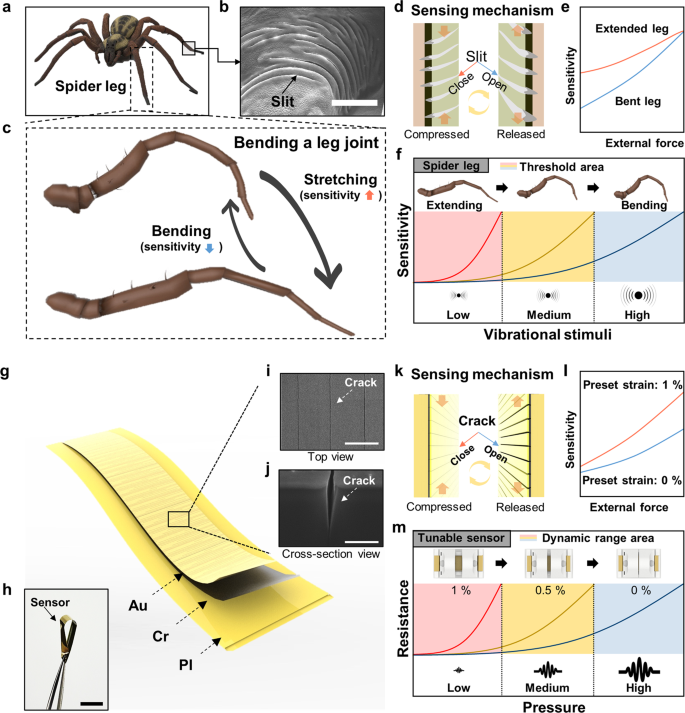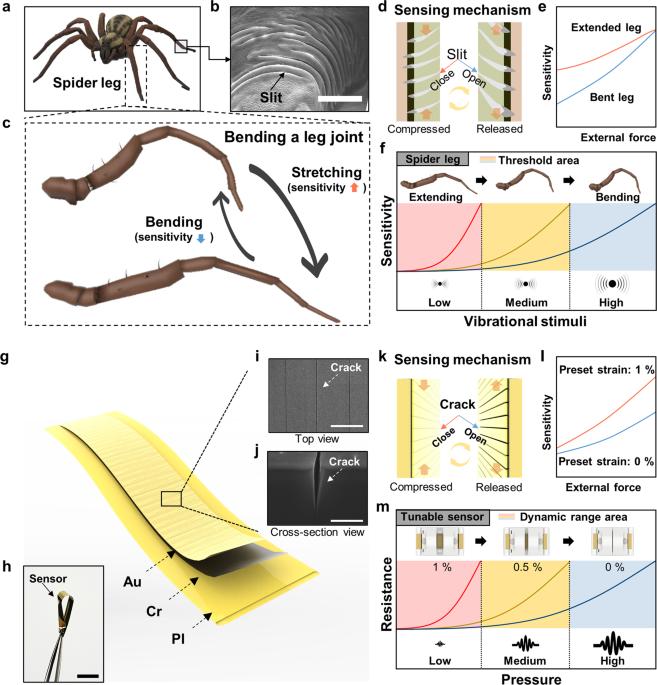生物医学应用的蜘蛛式可调机械传感器
IF 12.3
1区 材料科学
Q1 ENGINEERING, ELECTRICAL & ELECTRONIC
引用次数: 4
摘要
近年来,可穿戴传感器取得了令人瞩目的进步,但仍存在一些局限性,即需要重新制造传感器,以便根据目标信号调整传感器。然而,生物传感系统具有根据外部环境调整其灵敏度的内在潜力,从而实现更广泛、更强大的检测。在这里,我们开发了一种受大自然启发的可调谐超灵敏表皮传感器(TUNES),它的应变灵敏度大幅提高(GF ~30k),压力灵敏度可通过预设膜张力进行调谐(10-254 kPa-1)。该传感器可通过预设张力调整对压力机制的灵敏度,因此它能在很宽的范围(0.05 Pa-25 kPa)内以最佳性能进行测量:从极小的信号(如微小脉搏)到相对较大的信号(如肌肉收缩和呼吸)。我们通过临床试验验证了它作为可穿戴健康监测系统的能力,并与被认为是目前血压黄金标准的压力线(r = 0.96)和家庭保健系统进行了比较,通过机器学习对老/年轻脉搏波进行二元分类(准确率为 95%)。本文章由计算机程序翻译,如有差异,请以英文原文为准。


Spider-inspired tunable mechanosensor for biomedical applications
The recent advances of wearable sensors are remarkable but there are still limitations that they need to be refabricated to tune the sensor for target signal. However, biological sensory systems have the inherent potential to adjust their sensitivity according to the external environment, allowing for a broad and enhanced detection. Here, we developed a Tunable, Ultrasensitive, Nature-inspired, Epidermal Sensor (TUNES) that the strain sensitivity was dramatically increased (GF ~30k) and the pressure sensitivity could be tuned (10–254 kPa−1) by preset membrane tension. The sensor adjusts the sensitivity to the pressure regime by preset tension, so it can measure a wide range (0.05 Pa–25 kPa) with the best performance: from very small signals such as minute pulse to relatively large signals such as muscle contraction and respiration. We verified its capabilities as a wearable health monitoring system by clinical trial comparing with pressure wire which is considered the current gold standard of blood pressure (r = 0.96) and home health care system by binary classification of Old’s/Young’s pulse waves via machine learning (accuracy 95%).
求助全文
通过发布文献求助,成功后即可免费获取论文全文。
去求助
来源期刊

npj Flexible Electronics
Multiple-
CiteScore
17.10
自引率
4.80%
发文量
91
审稿时长
6 weeks
期刊介绍:
npj Flexible Electronics is an online-only and open access journal, which publishes high-quality papers related to flexible electronic systems, including plastic electronics and emerging materials, new device design and fabrication technologies, and applications.
 求助内容:
求助内容: 应助结果提醒方式:
应助结果提醒方式:


